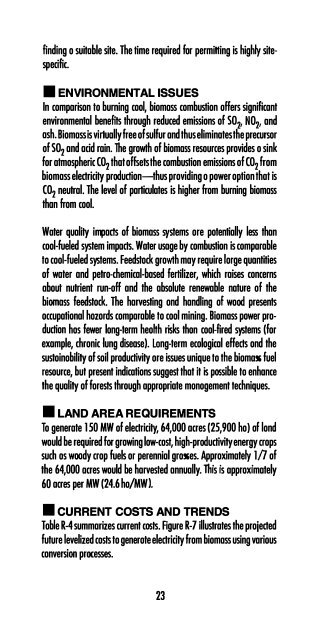DSM Pocket Guidebook Volume 5: Renewable and Related ... - NREL
DSM Pocket Guidebook Volume 5: Renewable and Related ... - NREL
DSM Pocket Guidebook Volume 5: Renewable and Related ... - NREL
Create successful ePaper yourself
Turn your PDF publications into a flip-book with our unique Google optimized e-Paper software.
finding o suitable site. The time required for permitting is high sitespecific<br />
.<br />
• ENVIRONMENTAL ISSUES<br />
In comparison to burning cool, biomass combustion offers significant<br />
environmental benefits through reduced emissions of S02, N02, <strong>and</strong><br />
ash. Biomass is virtually free of sulfur <strong>and</strong> thus eliminates the precursor<br />
of S02 <strong>and</strong> acid rain. The growth of biomass resources provides o sink<br />
for atmospheric C02 that offsets the combustion emissions of C02 from<br />
biomass electricity production-thus providing o power option that is<br />
C02 neutral. The level of particulates is higher from burning biomass<br />
than from cool.<br />
Water quality impacts of biomass systems ore potentially less than<br />
cool-fueled system impacts. Water usage by combustion is comparable<br />
to cool-fueled systems. Feedstock growth may require Iorge quantities<br />
of water <strong>and</strong> petro-chemical-based fertilizer, which raises concerns<br />
about nutrient run-off <strong>and</strong> the absolute renewable nature of the<br />
biomass feedstock. The harvesting ond h<strong>and</strong>ling of wood presents<br />
occupational hozords comparable to cool mining. Biomass power production<br />
hos fewer long-term heoh risks thon cool-fired systems (for<br />
example, chronic lung disease). long-term ecological effects ond the<br />
sustoinobility of soil productivity ore issues unique to the biomass fuel<br />
resource, but present indications suggest that it is possible to enhance<br />
the quality of forests through appropriate monogement techniques .<br />
• LAND AREA REQUIREMENTS<br />
To generate 150 MW of electricity, 64,000 acres (25,900 hoi of lond<br />
would be required for growing low-cost, high-productivity energy crops<br />
such os woody crop fuels or perennial grosses. Approximate 1/7 of<br />
the 64,000 acres would be harvested annually. This is approximately<br />
60 acres per MW (24.6 ho/MWI .<br />
• CURRENT COSTS AND TRENDS<br />
Tobie R-4 summarizes current costs. Figure R-7 illustrates the projected<br />
future levelized costs to gene rote electricity from biomass using various<br />
conversion processes.<br />
23
















